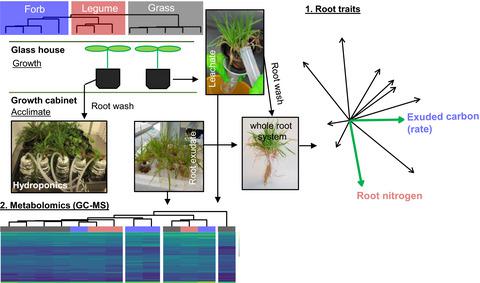Our official English website, www.x-mol.net, welcomes your
feedback! (Note: you will need to create a separate account there.)
Root functional traits explain root exudation rate and composition across a range of grassland species
Journal of Ecology ( IF 5.3 ) Pub Date : 2021-02-20 , DOI: 10.1111/1365-2745.13630 Alex Williams 1 , Holly Langridge 1 , Angela L. Straathof 1, 2 , Howbeer Muhamadali 3 , Katherine A. Hollywood 4 , Royston Goodacre 3 , Franciska T. de Vries 1, 5
中文翻译:

根功能性状解释了一系列草原物种的根分泌率和组成
更新日期:2021-02-20
Journal of Ecology ( IF 5.3 ) Pub Date : 2021-02-20 , DOI: 10.1111/1365-2745.13630 Alex Williams 1 , Holly Langridge 1 , Angela L. Straathof 1, 2 , Howbeer Muhamadali 3 , Katherine A. Hollywood 4 , Royston Goodacre 3 , Franciska T. de Vries 1, 5
Affiliation

|
- Plant root exudation is a crucial means through which plants communicate with soil microbes and influence rhizosphere processes. Exudation can also underlie ecosystem response to changing environmental conditions. Different plant species vary in their root exudate quantity and quality, but our understanding of the plant characteristics that drive these differences is fragmentary. We hypothesised that root exudates would be under phylogenetic control and fit within an exploitative root nutrient uptake strategy, specifically that high rates of root exudation would link to root traits indicative of exploitative growth.
- We collected root exudates from plants grown in field soil, as well as leachates of the entire plant–soil system, to assess both the quantity and quality of root exudates, and their interaction with the soil metabolome, across 18 common grassland species.
- We found that exudation varied with plant functional group and that differences were trait dependent. Particularly, root diameter, root tissue density and root nitrogen content explained much of the variation in exudate metabolome, along with plant phylogeny. Specific root exudation rate was highest in forbs and was negatively correlated with root tissue density, a trait indicative of conservative resource-use strategy, and positively correlated with root diameter, which is associated with microbial collaboration and resource uptake ‘outsourcing’.
- Synthesis. We provide novel insight into species-specific differences in root exudates and identify root functional traits that might underlie these differences. Our results show that root exudation fits, although not entirely, within current models of the root economic space, with strong positive relationships to outsourcing traits like high root diameter. Determining the role of root exudates as a key facet of the resource-outsourcing strategy necessitates further research into the fundamental controls on root exudation quantity and quality, particularly during environmental change.
中文翻译:

根功能性状解释了一系列草原物种的根分泌率和组成
- 植物根系分泌是植物与土壤微生物交流并影响根际过程的重要手段。渗出液也可能是生态系统对不断变化的环境条件作出反应的基础。不同植物物种的根系分泌物数量和质量各不相同,但我们对导致这些差异的植物特征的理解是零碎的。我们假设根系分泌物将受到系统发育控制,并符合开发性根系养分吸收策略,特别是高根系分泌物与指示开发性生长的根性状有关。
- 我们收集了在田间土壤中生长的植物的根系分泌物,以及整个植物-土壤系统的渗滤液,以评估 18 种常见草原物种的根系分泌物的数量和质量,以及它们与土壤代谢组的相互作用。
- 我们发现渗出物因植物功能组而异,并且差异取决于性状。特别是,根直径、根组织密度和根氮含量解释了渗出物代谢组的大部分变化,以及植物系统发育。比根分泌率在杂草中最高,与根组织密度呈负相关,这是一种表明保守的资源利用策略的特征,与根直径呈正相关,这与微生物协作和资源吸收“外包”有关。
- 合成。我们提供了对根系分泌物中物种特异性差异的新见解,并确定了可能构成这些差异的根系功能特征。我们的研究结果表明,尽管不完全符合根系经济空间的当前模型,但根系分泌物与高根直径等外包特征具有很强的正相关关系。确定根系分泌物的作用是资源外包战略的一个关键方面,需要进一步研究对根系分泌物数量和质量的基本控制,特别是在环境变化期间。









































 京公网安备 11010802027423号
京公网安备 11010802027423号